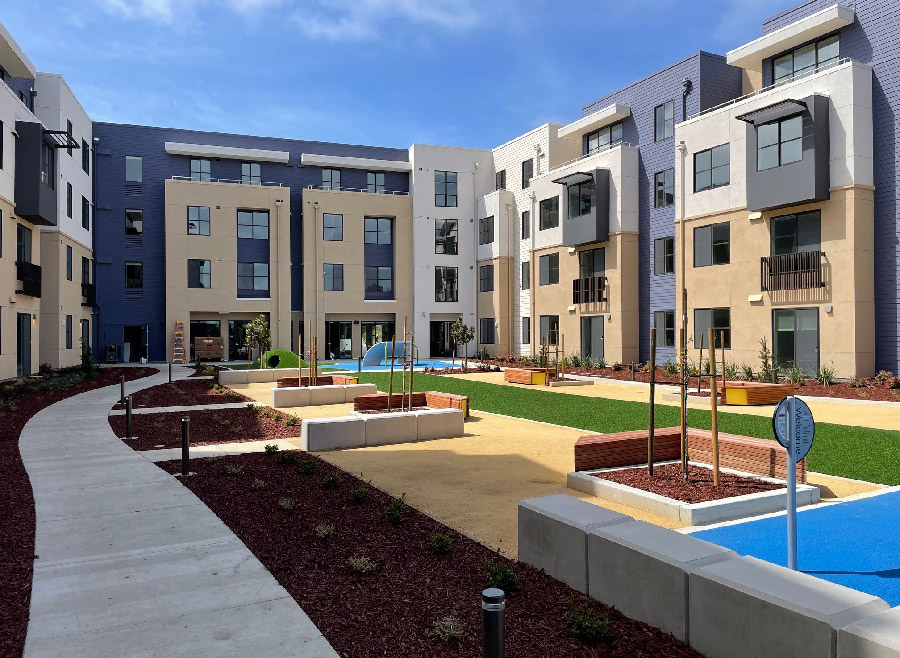An Affordable Place to Call

How education workforce housing can help solve staffing shortages
By Kimberly Sellery

eadlines this year in newspapers across the state have trumpeted word of a severe teacher shortage — an issue that has built for years and was exacerbated by the COVID-19 pandemic. The average yearly teacher turnover rate in California is 16.5 percent, with 8.5 percent leaving the profession and 8 percent leaving their current school for another, according to a 2018 Learning Policy Institute analysis. In one in 10 districts, however, the teacher turnover rate is 25 percent or higher.
California’s ongoing teacher shortage makes it difficult to fully support the state’s nearly 6 million public school students in obtaining optimal outcomes. When districts cannot fill a position with a qualified teacher, options include long-term substitutes or teachers with substandard credentials, leaving positions vacant, increasing class sizes or canceling courses — all of which affect student achievement negatively. Many sectors are working to alleviate this issue through initiatives such as grow-your-own programs, adjusting credentialing requirements and creating career pathways. In addition, teaching is not the only position experiencing staffing issues, which extend to many corners of the education workforce including paraprofessionals, counselors, cafeteria workers and more.

ne of the more innovative solutions to address the education staffing crisis is explored in a new report, Education Workforce Housing: Developing the 21st-Century Campus, a collaboration by cityLAB; the Center for Cities + Schools at the University of California, Berkeley; the Terner Center for Housing Innovation; and CSBA, with support from the Chan Zuckerberg Initiative. This in-depth research report examines the need for education workforce housing and the steps local educational agencies can take to leverage underutilized school lands for this purpose.
An analysis in the report of land owned by LEAs in California found there are 7,068 properties with potentially developable land of one acre or more, totaling 75,000 acres statewide. More than half (61 percent) of these properties are located where beginning teachers face housing affordability challenges and would benefit from renting at below-market rates.
Housing affordability in California
The Education Workforce Housing report found that housing costs in California are outpacing education salaries by wide margins. A 2016 Redfin study found that only 17.4 percent of homes for purchase in California were affordable on the average teacher salary, down from 30 percent in 2012. In high-cost counties like Alameda, only 1.2 percent of homes on the market were affordable for the average teacher, a drastic drop from 14.5 percent in 2012. In San Francisco, 0.2 percent of homes were affordable to the average teacher in 2016. In both Santa Clara and San Mateo counties, 0 percent of homes were affordable on the average teacher salary in 2016.
 It’s not isolated to the more traditionally high cost or coastal areas — it really is a statewide problem.”
It’s not isolated to the more traditionally high cost or coastal areas — it really is a statewide problem.”—Jeff Vincent, director of the Center for Cities & Schools at UC Berkeley
And housing unaffordability is not limited to coastal cities and the Bay Area, according to Jeff Vincent, report contributor and director of the Center for Cities & Schools at UC Berkeley.
Assembly Bill 2295 (Bloom, D-Santa Monica), if passed, would remove bureaucratic hurdles and provide greater incentives for school districts to develop education workforce housing on vacant school property. As this issue went to publication, the bill was set for an Appropriations committee hearing, which precedes floor votes to send the bill to the Governor.

“All in all, we found that basically half of all California districts are located in counties where someone earning a beginning teacher salary really couldn’t afford median asking rent prices in that county,” Vincent said.


Jefferson Union HSD Trustee Andrew Lie said the district experiences an average annual turnover of 25 percent of its staff and faces further challenges as the lowest funded district in San Mateo County. The basic aid district just qualifies for that status at about 110 percent of Local Control Funding Formula base funding; in comparison, Lie said that neighboring basic aid districts are operating on up to 170 percent of LCFF base funding. “We needed to do something dramatic in order to make sure we can retain staff — and that is when we looked at staff housing.”
While investigating the feasibility of underutilized property, the district conducted an employee survey in which 63 percent of respondents said they were interested in district-built housing. Of those, 35 percent indicated that they intended to leave the district within the next five years due to housing costs. The feasibility study identified a surface parking lot outside of the district office as a prime spot for workforce housing. The next step was figuring out how to finance the project.
 We needed to do something dramatic in order to make sure we can retain staff — and that is when we looked at staff housing.”
We needed to do something dramatic in order to make sure we can retain staff — and that is when we looked at staff housing.”The district held community outreach meetings to share information and discuss the project, which faced little opposition. It worked closely with its teachers union to show how the project benefitted everyone — not just those living in the below-market rate housing. “Some of the more senior staff wanted to know the benefits for them,” Lie explained. “We were able to then message to them — ‘You’re going to have consistent colleagues. We’re not going to have to rehire and retrain staff every year. We can guarantee that your colleagues will be here for the life of a high school career for a student.’”
The following resources can be found at www.csba.org/workforcehousing:
- Report: Education Workforce Housing: Developing the 21st-Century Campus
- Handbook: Education Workforce Housing in California – this accompanying handbook is intended as an action-oriented companion to the full research report.
 AEC session: Workforce Housing Panel: Strategies Using Existing Property and Stories From the Field
AEC session: Workforce Housing Panel: Strategies Using Existing Property and Stories From the Field
That savings has allowed sixth-year teacher Lisa Raskin to upgrade to solo living. Raskin transitioned to teaching mid-career and is excited for the opportunity to move into district housing. “I have a roommate and my space right now is tiny,” she said. “I just feel like I’m at that age now where I want my own space. The affordability is perfect for my price point, with my salary.”

 Largely, it’s making sure that there’s buy-in from the local community and that this is not a point of contention because these projects, though they take a long time, can be a really valuable asset for the community if it’s done right.”
Largely, it’s making sure that there’s buy-in from the local community and that this is not a point of contention because these projects, though they take a long time, can be a really valuable asset for the community if it’s done right.”
Santa Clara USD trustee and CSBA Vice President Albert Gonzalez said the housing is great for the teachers — and also for students. “The Santa Clara Unified school board supports workforce housing due to the incredibly high cost of housing in our community and the desire to have our teachers live close to where they work. Our students have benefited in having Casa del Maestro, which houses 74 teachers, by retaining consistent teachers who live close to work, and thereby lessening their travel time to their classroom.”
The project initially contained 40 townhouses, but its success in retaining teachers made the case for 30 additional units, which house 10 percent of Santa Clara USD’s current teachers. The district funded the nearly $6.5 million construction of Casa del Maestro by issuing COPs. Meanwhile, independent third parties manage the financial transactions, along with the day-to-day operations of the housing complex. According to the district, this arrangement is designed to protect district dollars.
Comparing the cost of the Santa Clara project with that of Jefferson Union HSD’s ($75 million) illustrates the ways costs have risen astronomically in the last 20 years.
Develop partnerships with the community
While the community buy-in for the Jefferson Union HSD housing came easily, this is not always the case, especially with potential building sites in residential, single-family home neighborhoods. CSBA’s Director of Special Projects Andrew Keller emphasized the importance of community partnerships throughout the process.
“Any time you’re using district property, it’s impacting a community because that community lives around it,” said Keller. “They have a vested interest in what happens there. Largely, it’s making sure that there’s buy-in from the local community and that this is not a point of contention because these projects, though they take a long time, can be a really valuable asset for the community if it’s done right. Community support is critical to sustaining the momentum of a project.”
Prepare for a lengthy process
Over the life of the project, there will be changes in community issues, school board membership, housing and construction costs, and other relevant concerns. The most important stabilizing factor will be thoughtful due diligence that gives confidence to the stakeholders, which will serve as the foundation when necessary adaptations arise. LEAs and governance teams must commit and identify ongoing leadership that can advance such initiatives over the long timeframes they require.
Design solutions must be specific
Any project for education workforce housing will need to negotiate specific conditions on the ground in communities with a wide range of circumstances and challenges. One of the most significant issues is how to envision the change all stakeholders want to see. Design studies and alternatives can help everyone visualize the possibilities and be a means to gather specific suggestions. Using architectural design in this manner, particularly in the early phases of a project, can offer assurance as well as accountability.
Keep the process transparent
To build trust with the community, projects must be transparent, with input from the community. Bringing examples and using models can build a shared understanding of the possibilities, constraints, choices and tradeoffs that may be required for a successful project. Defining project goals along with the surrounding community sets up the process for success.
CSBA will continue to provide resources and support for districts interested in building workforce housing. Through an additional grant from the Chan Zuckerberg Initiative, CSBA will be creating a resource library with sample documents related to steps throughout the process. In addition, the association is in the initial stages of putting together a small cohort of districts that plan on building workforce housing for a series of workshops.
Kimberly Sellery is editorial director for California Schools..